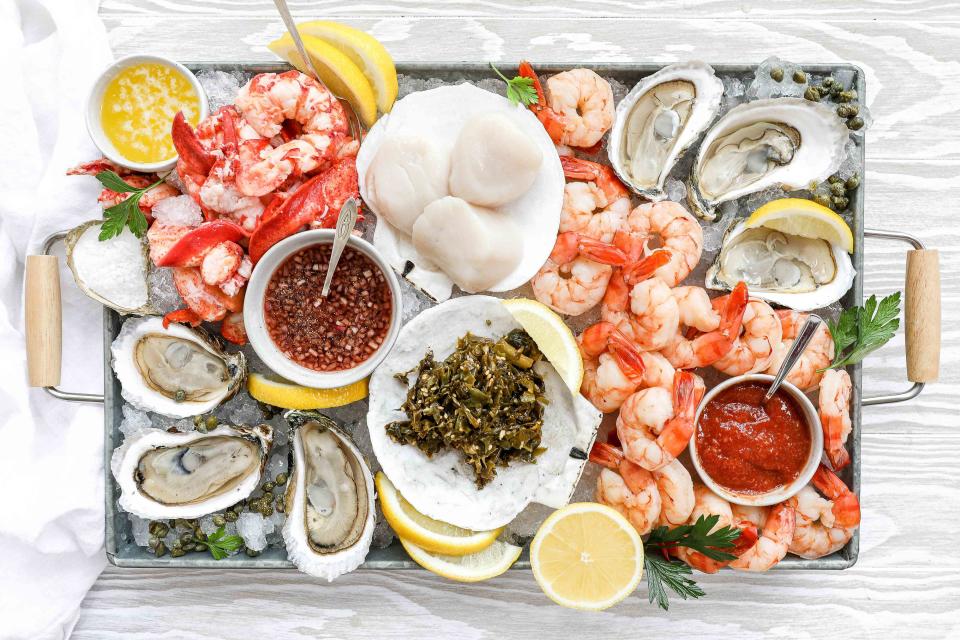How to Build a Seacuterie Board
This board idea may be the summer's hottest entertaining trend.

Jenny Rawn
It seems we aren't quite bored of boards yet. While people still build charcuterie boards, dessert boards, and yes, even butter boards, the latest trend for goodies to slap on a big board is perfect for the casual, beachy days of summer. Enter the seacuterie board, which features variations on seafood (with their perfect accompaniments) that people can sample to their heart's content.
"Seacuterie boards are a show-stopper," says Jenny Shea Rawn, M.S., MPH, R.D., author of the upcoming cookbook Coastal Kitchen, and one of the first to pick up on the seacuterie trend. "They are gorgeous, unexpected, and can be a bit over-the-top. Plus, seafood tends to be thought of as special and saved for special occasions, so there is something extraordinary about serving a beautiful platter of seafood."
Related: The Lazy Way to a Whip Up a Perfect Charcuterie Board
If you're thinking raw bar and big dollar signs, know that a seacuterie board doesn't have to be pricy. "Seacuterie boards can be made on any budget," Rawn says. "So, yes, some seacuterie boards can be chock full of lobster, crab and scallops, but they can also be compiled using common ingredients from your pantry and fridge—think tinned tuna or salmon and sardines."
Choose your seafood varieties
When it comes to what seafood to pick for your seacuterie board, the more the merrier—and don't be afraid to mix in different preparations too. "Combine fresh seafood—raw and cooked—with tinned seafood and even dried seafood like tuna jerky," Rawn says.
Make sure to offer things for different adventurous eater levels—you'll always want to include something simple like cooked shrimp along with more daring options like raw oysters.
Add some great sauces and accompaniments
Rawn usually includes sauces like cocktail sauce, tartar sauce, and mignonette, or even some flavored melted butter—which is fantastic with lobster, of course.
Related: Orange-Chili Shrimp Cocktail
Toasted bread is great for spreading sauces and topping with seafood, and of course, lemon or lime wedges are essential squeezing over the seafood. "A good seacuterie board will have a few seafood options, something briny and tangy—think capers, olives, pickles, pickled onions—and we love Atlantic Sea Farms fermented products made with kelp, like Sea-Chi and Seaweed Salad," Rawn says.
Don't forget some goodies for people who don't love seafood
Even seafood fans may want a break from all the ocean-y goodness, so make sure to include a few additional items on the board that don't come from the sea. "Serve a soft creamy cheese—Boursin is always a nice pairing—some crackers and perhaps some salted nuts as well," Rawn says.
Consider a theme
You might want to change up the seacuterie board, depending on the season or the guest list. Rawn's summer favorite seacuterie board includes fresh-cooked lobster meat and shrimp, raw oysters and seaweed salad, with a few sauces and capers. You could also go with all grilled seafood, or opt for all tinned items, which makes a seacuterie board more picnic-friendly.
Rawn is also a huge fan of a lobster BLT board, which is a swanky upgrade of the traditional lunch sandwich.
Keep food safety in mind
While leaving charcuterie boards out in the summer heat for hours is also a definite no-no, a seacuterie board definitely needs a little extra care in presentation and safety—because no one wants to give their party guests food poisoning.
In most cases, Rawn recommends using a tray with a lip and filling it with ice if you're doing a fully chilled seacuterie board, or ensuring chilled fish is served in a bowl over ice if there are some grilled or dried items that don't need to be kept as cold. "If it's a small group and you expect the board to be gone in minutes, you may not need to serve it over ice," she says. "But if it'll be sitting out for a bit before guests eat it all, then ice is a good idea."
Related: How to Select, Store, and Serve Seafood Safely, According to an Expert
Pro tip: You can also keep the seacuterie board on the small side, and stash extras in your fridge to replenish with fresh chilled items as it gets depleted.
Be especially careful about serving raw or undercooked seafood if your guest list includes people who are pregnant or immunocompromised, young children or older adults, as that can put them at risk of foodborne illnesses, Rawn says. And follow all FDA food safety practices, which means you should toss out food that's been left out for more than two hours (or more than an hour if it's a 90-degree day.)
Have all the right tools in place
To keep things sanitary, make sure you have plenty of tongs, forks, sauce spoons, and other accoutrements for guests to serve themselves. And don't forget that those shrimp tails and oyster shells need somewhere to go, so make sure to place a bucket or bowl (or a trash can) near the seacuterie board where people can ditch their trash.
Have fun with the presentation
Like other boards, putting together a pretty seacuterie board is all about the presentation. Rawn likes to place cooked seafood onto a bed of salt—either pink Himalayan or Celtic sea salt (perfect for sprinkling on the seafood as well!). Slices of citrus can also be a base layer for seafood. And look for ways to incorporate the watery theme—such as using cleaned sea shells to hold seafood or sauces.
For more Real Simple news, make sure to sign up for our newsletter!
Read the original article on Real Simple.

 Yahoo News
Yahoo News 
